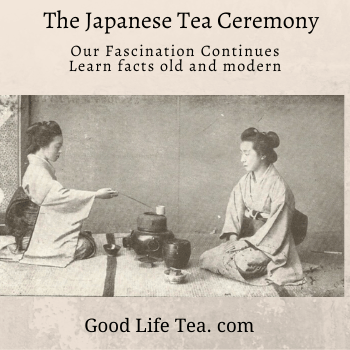
The very first western travelers to Japan were fascinated by Japanese culture especially the tea ceremony. Today, one does not have to travel to Japan to partake in the traditional tea ceremony or to enjoy the matcha tea which is served.
A Buddhist monk in the 9th century served tea to the Emperor Saga, the ruler of Japan at that time while he was on his trip to the Karasaki village. This is the first documented instance of the tea ceremony.  Later circa the 12 century, a monk known as Eisai prepared a unique variety of tea that was a powdered green tea (matcha) when he returned from his trip to China where studied Buddhism and tea. The powered tea was stirred into a bowl of hot water. He wrote the first Japanese book on tea in 1211 - Kissa Yojoki – How to Stay Healthy by Drinking Tea. In this book he stated - "Tea is the ultimate mental and medical and medical remedy and has the ability to make one’s life more full and complete”. (This ancient wisdom still prevails today). This book and his tea seeds he brought from China, introduced Japan to its own tea journey. Later in the 16th century, Sen no Rikyu, a Japanese tea expert popularized several methods of drinking tea and propagated how every ceremony was meant to uphold the principles of purity, tranquility, and respect. The Japanese tea ceremony, also commonly known as Chanoyu is based upon preparing Matcha (a ground up powder form of green tea - think wheat to flour) and then serving it alongside some traditional sweets to balance out the subtle bitter flavor of the tea.
Later circa the 12 century, a monk known as Eisai prepared a unique variety of tea that was a powdered green tea (matcha) when he returned from his trip to China where studied Buddhism and tea. The powered tea was stirred into a bowl of hot water. He wrote the first Japanese book on tea in 1211 - Kissa Yojoki – How to Stay Healthy by Drinking Tea. In this book he stated - "Tea is the ultimate mental and medical and medical remedy and has the ability to make one’s life more full and complete”. (This ancient wisdom still prevails today). This book and his tea seeds he brought from China, introduced Japan to its own tea journey. Later in the 16th century, Sen no Rikyu, a Japanese tea expert popularized several methods of drinking tea and propagated how every ceremony was meant to uphold the principles of purity, tranquility, and respect. The Japanese tea ceremony, also commonly known as Chanoyu is based upon preparing Matcha (a ground up powder form of green tea - think wheat to flour) and then serving it alongside some traditional sweets to balance out the subtle bitter flavor of the tea.
 Preparing tea in this ceremony needs to fulfill a set of prerequisites; the entire arrangement is not simply about drinking the tea, but mainly concerns the aesthetics of preparing a bowl of tea with positivity, love and attention. The host of the ceremony takes all of the guests into consideration; even placement of the bowls of tea on the table are prescribed with the main with emphasis on the main honored guest, Shokyaku. People serving and receiving the tea first exchange bows, then the guest rotates the bowl to avoid drinking it from the front and takes a sip to later compliment the maker. It is a very formal ceremony with a strict protocol which has not changed much over the years.
Preparing tea in this ceremony needs to fulfill a set of prerequisites; the entire arrangement is not simply about drinking the tea, but mainly concerns the aesthetics of preparing a bowl of tea with positivity, love and attention. The host of the ceremony takes all of the guests into consideration; even placement of the bowls of tea on the table are prescribed with the main with emphasis on the main honored guest, Shokyaku. People serving and receiving the tea first exchange bows, then the guest rotates the bowl to avoid drinking it from the front and takes a sip to later compliment the maker. It is a very formal ceremony with a strict protocol which has not changed much over the years.
In America, the Japanese tea ceremony is accepted and celebrated with all its authenticity intact. In major cities, you can partake in a tea ceremony with an experienced trained student (practitioners are forever students.)
Today, Americans are mostly obsessed with drinking matcha; appreciating it for its solitary flavor and the innumerable health benefits. It is the perfect balance of seaweed, malty and vegetal flavors that fascinate the Americans’ palate.
Making Matcha is rather simple and Americans have embraced Eisai's teachings of good health with green tea. Matcha has become very popular and has found its way into smoothies, and other coffee shop offerings.
Check out our other articles on Matcha
